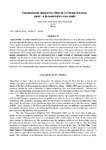Unconsciously interactive Films in a cinema environment—a demonstrative case study

Date
2018-07-03Author
Metadata
Show full item recordAbstract
© 2018 Informa UK Limited, trading as Taylor & Francis Group ‘Many worlds’ is a short narrative live-action film written and directed so as to provide multiple linear routes through the plot to one of four endings, and designed for showing in a cinema environment. At two points during the film, decisions are made based on audience bio-signals as to which plot route to take. The use of bio-signals is to allow the audience to remain immersed in the film, rather than explicitly selecting plot direction. Four audience members have a bio-signal measured sensor for each person: ECG (heart rate), EMG (muscle tension), EEG (‘brain waves’) and Galvanic Skin Response (perspiration). The four are interpreted as a single average of emotional arousal. ‘Many worlds’ was the first live-action linear plotted film to be screened in a cinema to the general public utilizing multiple biosensor types. The film has been shown publically a number of times, and lessons learned from the technical and cinematic production are detailed in this paper.
Collections
Publisher
Journal
Volume
Issue
Pagination
Number
Recommended, similar items
The following license files are associated with this item:

